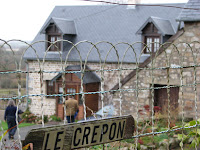 With Alan Smith we went on a road trip to France to visit his sister and her husband, Ann and Barry Burrell near the small village of Le Mesnil Gilbert in the Normandy region. This involved a short drive from Alan's house to the port of Newhaven, a four hour ferry crossing to Dieppe and then a three hour drive to Ann and Barry's.
With Alan Smith we went on a road trip to France to visit his sister and her husband, Ann and Barry Burrell near the small village of Le Mesnil Gilbert in the Normandy region. This involved a short drive from Alan's house to the port of Newhaven, a four hour ferry crossing to Dieppe and then a three hour drive to Ann and Barry's.
Ann and Barry are retired and have done a wonderful job of restoring an old barn which is now their house. They lived in a small cottage on the same property while they worked on the barn. The barn was derelict when they purchased the property, having been badly burned by the retreating German army in 1944.

We spent a lot of time sitting around eating and drinking but found time for a couple of walks around the neighbourhood. There were not many leaves left on the trees but found lots of mistletoe growing up in the branches of some trees - the seeds having been put there by birds.

Some of the local farm houses had round extensions on the ends of them - these contained cooking ovens.

On the way to Le Mesnil Gilbert we stopped at the village of Yerville to sample some of the local foods and stock up on cheese and specialist meat products. There were quite a few traditional board and plaster farm houses in this region.














































